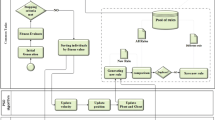Abstract
In this paper, a genetic algorithm (GA) is proposed as a search strategy for not only positive but also negative quantitative association rule (AR) mining within databases. Contrary to the methods used as usual, ARs are directly mined without generating frequent itemsets. The proposed GA performs a database-independent approach that does not rely upon the minimum support and the minimum confidence thresholds that are hard to determine for each database. Instead of randomly generated initial population, uniform population that forces the initial population to be not far away from the solutions and distributes it in the feasible region uniformly is used. An adaptive mutation probability, a new operator called uniform operator that ensures the genetic diversity, and an efficient adjusted fitness function are used for mining all interesting ARs from the last population in only single run of GA. The efficiency of the proposed GA is validated upon synthetic and real databases.
Similar content being viewed by others
References
Han J, Kamber M (2001) Data mining: concepts and techniques. Morgan Kaufmann, Academic, San Fransisco, New York
Karcı A (2004) Novelty in the generation of initial population for genetic algorithms. Knowledge-based intelligent information and engineering systems. Part II In: 8th International conference KES 2004 (LNAI), Wellington, New Zealand, 3214: 268–276
Agrawal R, Imielinski T, Swami AN (1993) Mining association rules between sets of items in large databases. In: Proceedings of the ACM SIGMOD, Washington, D.C. 207–216
Srikant R, Agrawal R (1996) Mining quantitative association rules in large relational tables. In: Proceedings ACMSIGMOD 1–12
Fukada T, Yasuhiko M, Sinichi M, Tokuyama T (1996) Mining optimized association rules for numeric attributes. In: Proceedings of the ACM SIGMOD International conference on management of data, Montreal Canada, 13–23
Aumann Y, Lindell Y (1999) A statistical theory for quantitative association rules. In: Proceedings of the 5th ACM SIGKDD International conference on knowledge discovery and data mining, 261–270.
Mata J, Alvarez JL, Riquelme JC (2002) Discovering numeric association rules via evolutionary algorithm. In: 6th Pacific-Asia conference on knowledge discovery and data mining PAKDD-02 (LNAI) Taiwan 2336: 40–51
Guvenir HA, Uysal I (2000) Bilkent University Function Approximation Repository. http://funapp.cs.bilkent.edu.tr
Author information
Authors and Affiliations
Corresponding author
Rights and permissions
About this article
Cite this article
Alataş, B., Akin, E. An efficient genetic algorithm for automated mining of both positive and negative quantitative association rules. Soft Comput 10, 230–237 (2006). https://doi.org/10.1007/s00500-005-0476-x
Published:
Issue Date:
DOI: https://doi.org/10.1007/s00500-005-0476-x




